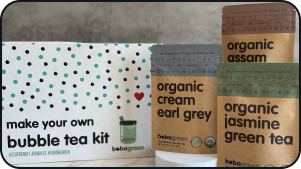Uniquely beautiful both for the look and the taste, the big sister of the boba family - Taro Boba, is almost a classic.

What is taro?
Taro is a root vegetable (colocasia esculenta) that can be found in tropical and humid environments places like Africa and Asia.
From outside, taro root appears like any other root vegetable brown and fuzzy. But on the inside, it is pale white with specs of purple all around the inner root. Taro has a potato-like structure, with a starchy texture.
Taro also plays an important role with Hawaiian. With them, the taro plants are beyond food. It was considered an elder sibling to the Hawaiian race.
In tales of taro's origins, it is the stillborn first child of Wakea, the sky father, and his daughter Ho`ohokukalani (daughter to Papa, the earth mother). This child was buried near the house and grew into a taro plant they named Haloanaka, or long stalk trembling.
The second son born to Wakea and Ho`ohokukalani took human form and was named Haloa after his elder brother. From this Haloa the human race descended. Thus Hawaiians as a people understood themselves to be closely related to taro.
How does taro boba taste like?
Taro milk tea, with or without boba, wins over many people’s hearts with its rich, creamy, and full of sweet flavors.
It is an elegant and possibly florally from taro itself and from the accompanying tea, with a hint of vanilla. Basically, if you are a big fan of vanilla flavor, you will also fall in love with taro boba.
How to make taro boba?
There are plenty of recipes out there to make homemade taro boba. We have collected some recipes to use as guidelines during your experiment to design your own signature taro boba.
Level 1: Taro Boba without tea
This recipe will give you a beverage with a bright purple color. It also balances the flavors between taro, sugar, and cream.
- 3 tablespoons of taro powder
- 3 tablespoons of non-dairy creamer
- 2 teaspoons of cane sugar/ honey/syrup
- 1 ¼ cups of water.
Shake these ingredients together until the mixture is smooth, add ice if needed. Add a cup of cooked tapioca pearls if you want to and enjoy your taro boba!

Level 2: Taro boba with black tea
If you would love to have a balance between taro and black tea, this drink is for you. This combination creates lighter taro and less creamy flavor compared to other recipes. It also has a dark purple hue that makes it stands out in the line of taro beverages.
- 3 tablespoons of taro powder
- 3 tablespoons of non-dairy creamer
- 2 teaspoons of cane sugar/ honey/syrup
- 1 ¼ cups of hot black tea
Shake these ingredients together until the mixture is smooth. Add cooked tapioca pearls if you want to and enjoy it!

Level 3: Simple Taro Milk Tea with green tea
- 5 tablespoons/1.5oz taro powder
- 5oz hot green tea
- ⅓ cup cooked boba/ tapioca pearls
- 1 cup ice
- In a shaker cup, mix taro powder in hot tea to dissolve.
- Add ice, shake well.
- Pour over cooked tapioca pearls in a glass container for an aesthetic view.
Don't forget a fat straw, preferably a reusable one because you will want to have boba again, and enjoy!

Level 4: Chef Iso’s Taro Milk Tea, inspired by the Boba Guys.
- 1 tablespoon of loose-leaf jasmine green tea
- 4 tablespoons Taro Powder
- 1/2 cup sugar + 1/2 cup water (to make syrup for the pearls)
- 1/2 cup half-and-half
- 1 cup of cooked boba/ tapioca pearls
- 3 tablespoons of cane sugar/ honey/syrup
- Ice
- Heat ½ cup of sugar with ½ cup of water until the sugar is fully dissolved. Add honey and pour the syrup to a bowl or jar. Add the cooked tapioca pearls in and soak them in the syrup for 25 – 60 minutes.
- Brew the tea. The ideal brewing temperature of jasmine green tea is 176°F (80°C) to extract the most flavor without getting bitter.
- Remove the tea leaves.
- Whisk in the taro powder until it fully dissolved and leaves you a pale purple color. If you have a cocktail share, add ice and pour in the taro tea. Shake until combined.
- Scoop the boba into two glasses, add ice then pour the taro tea in. Top with the half-and-half. Finish with bubble tea straws and stir the taro milk tea several times to swirl the milk and the tea together.





Comments (0)
There are no comments for this article. Be the first one to leave a message!